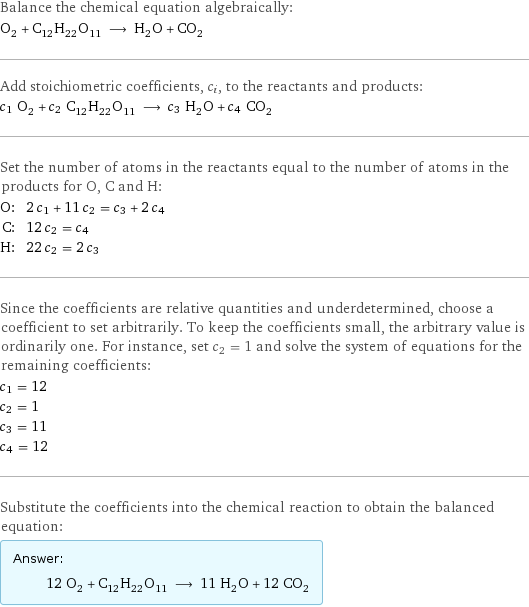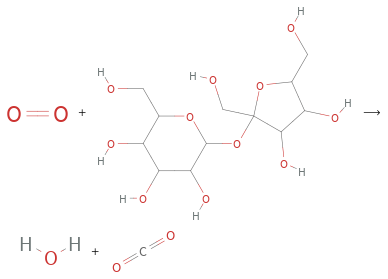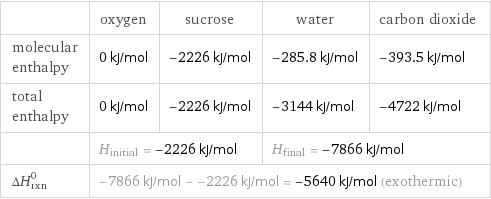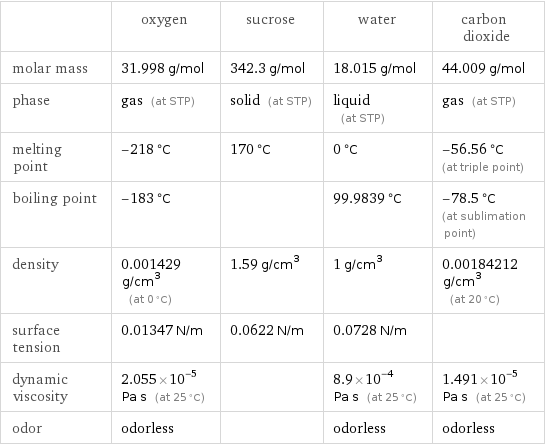Input interpretation

O_2 (oxygen) + C_12H_22O_11 (sucrose) ⟶ H_2O (water) + CO_2 (carbon dioxide)
Balanced equation

Balance the chemical equation algebraically: O_2 + C_12H_22O_11 ⟶ H_2O + CO_2 Add stoichiometric coefficients, c_i, to the reactants and products: c_1 O_2 + c_2 C_12H_22O_11 ⟶ c_3 H_2O + c_4 CO_2 Set the number of atoms in the reactants equal to the number of atoms in the products for O, C and H: O: | 2 c_1 + 11 c_2 = c_3 + 2 c_4 C: | 12 c_2 = c_4 H: | 22 c_2 = 2 c_3 Since the coefficients are relative quantities and underdetermined, choose a coefficient to set arbitrarily. To keep the coefficients small, the arbitrary value is ordinarily one. For instance, set c_2 = 1 and solve the system of equations for the remaining coefficients: c_1 = 12 c_2 = 1 c_3 = 11 c_4 = 12 Substitute the coefficients into the chemical reaction to obtain the balanced equation: Answer: | | 12 O_2 + C_12H_22O_11 ⟶ 11 H_2O + 12 CO_2
Structures

+ ⟶ +
Names

oxygen + sucrose ⟶ water + carbon dioxide
Reaction thermodynamics
Enthalpy

| oxygen | sucrose | water | carbon dioxide molecular enthalpy | 0 kJ/mol | -2226 kJ/mol | -285.8 kJ/mol | -393.5 kJ/mol total enthalpy | 0 kJ/mol | -2226 kJ/mol | -3144 kJ/mol | -4722 kJ/mol | H_initial = -2226 kJ/mol | | H_final = -7866 kJ/mol | ΔH_rxn^0 | -7866 kJ/mol - -2226 kJ/mol = -5640 kJ/mol (exothermic) | | |
Equilibrium constant
![Construct the equilibrium constant, K, expression for: O_2 + C_12H_22O_11 ⟶ H_2O + CO_2 Plan: • Balance the chemical equation. • Determine the stoichiometric numbers. • Assemble the activity expression for each chemical species. • Use the activity expressions to build the equilibrium constant expression. Write the balanced chemical equation: 12 O_2 + C_12H_22O_11 ⟶ 11 H_2O + 12 CO_2 Assign stoichiometric numbers, ν_i, using the stoichiometric coefficients, c_i, from the balanced chemical equation in the following manner: ν_i = -c_i for reactants and ν_i = c_i for products: chemical species | c_i | ν_i O_2 | 12 | -12 C_12H_22O_11 | 1 | -1 H_2O | 11 | 11 CO_2 | 12 | 12 Assemble the activity expressions accounting for the state of matter and ν_i: chemical species | c_i | ν_i | activity expression O_2 | 12 | -12 | ([O2])^(-12) C_12H_22O_11 | 1 | -1 | ([C12H22O11])^(-1) H_2O | 11 | 11 | ([H2O])^11 CO_2 | 12 | 12 | ([CO2])^12 The equilibrium constant symbol in the concentration basis is: K_c Mulitply the activity expressions to arrive at the K_c expression: Answer: | | K_c = ([O2])^(-12) ([C12H22O11])^(-1) ([H2O])^11 ([CO2])^12 = (([H2O])^11 ([CO2])^12)/(([O2])^12 [C12H22O11])](../image_source/bd29453d526333471c69d20bf4095bad.png)
Construct the equilibrium constant, K, expression for: O_2 + C_12H_22O_11 ⟶ H_2O + CO_2 Plan: • Balance the chemical equation. • Determine the stoichiometric numbers. • Assemble the activity expression for each chemical species. • Use the activity expressions to build the equilibrium constant expression. Write the balanced chemical equation: 12 O_2 + C_12H_22O_11 ⟶ 11 H_2O + 12 CO_2 Assign stoichiometric numbers, ν_i, using the stoichiometric coefficients, c_i, from the balanced chemical equation in the following manner: ν_i = -c_i for reactants and ν_i = c_i for products: chemical species | c_i | ν_i O_2 | 12 | -12 C_12H_22O_11 | 1 | -1 H_2O | 11 | 11 CO_2 | 12 | 12 Assemble the activity expressions accounting for the state of matter and ν_i: chemical species | c_i | ν_i | activity expression O_2 | 12 | -12 | ([O2])^(-12) C_12H_22O_11 | 1 | -1 | ([C12H22O11])^(-1) H_2O | 11 | 11 | ([H2O])^11 CO_2 | 12 | 12 | ([CO2])^12 The equilibrium constant symbol in the concentration basis is: K_c Mulitply the activity expressions to arrive at the K_c expression: Answer: | | K_c = ([O2])^(-12) ([C12H22O11])^(-1) ([H2O])^11 ([CO2])^12 = (([H2O])^11 ([CO2])^12)/(([O2])^12 [C12H22O11])
Rate of reaction
![Construct the rate of reaction expression for: O_2 + C_12H_22O_11 ⟶ H_2O + CO_2 Plan: • Balance the chemical equation. • Determine the stoichiometric numbers. • Assemble the rate term for each chemical species. • Write the rate of reaction expression. Write the balanced chemical equation: 12 O_2 + C_12H_22O_11 ⟶ 11 H_2O + 12 CO_2 Assign stoichiometric numbers, ν_i, using the stoichiometric coefficients, c_i, from the balanced chemical equation in the following manner: ν_i = -c_i for reactants and ν_i = c_i for products: chemical species | c_i | ν_i O_2 | 12 | -12 C_12H_22O_11 | 1 | -1 H_2O | 11 | 11 CO_2 | 12 | 12 The rate term for each chemical species, B_i, is 1/ν_i(Δ[B_i])/(Δt) where [B_i] is the amount concentration and t is time: chemical species | c_i | ν_i | rate term O_2 | 12 | -12 | -1/12 (Δ[O2])/(Δt) C_12H_22O_11 | 1 | -1 | -(Δ[C12H22O11])/(Δt) H_2O | 11 | 11 | 1/11 (Δ[H2O])/(Δt) CO_2 | 12 | 12 | 1/12 (Δ[CO2])/(Δt) (for infinitesimal rate of change, replace Δ with d) Set the rate terms equal to each other to arrive at the rate expression: Answer: | | rate = -1/12 (Δ[O2])/(Δt) = -(Δ[C12H22O11])/(Δt) = 1/11 (Δ[H2O])/(Δt) = 1/12 (Δ[CO2])/(Δt) (assuming constant volume and no accumulation of intermediates or side products)](../image_source/b37a5c49a99a7d8c4417260dcb903c20.png)
Construct the rate of reaction expression for: O_2 + C_12H_22O_11 ⟶ H_2O + CO_2 Plan: • Balance the chemical equation. • Determine the stoichiometric numbers. • Assemble the rate term for each chemical species. • Write the rate of reaction expression. Write the balanced chemical equation: 12 O_2 + C_12H_22O_11 ⟶ 11 H_2O + 12 CO_2 Assign stoichiometric numbers, ν_i, using the stoichiometric coefficients, c_i, from the balanced chemical equation in the following manner: ν_i = -c_i for reactants and ν_i = c_i for products: chemical species | c_i | ν_i O_2 | 12 | -12 C_12H_22O_11 | 1 | -1 H_2O | 11 | 11 CO_2 | 12 | 12 The rate term for each chemical species, B_i, is 1/ν_i(Δ[B_i])/(Δt) where [B_i] is the amount concentration and t is time: chemical species | c_i | ν_i | rate term O_2 | 12 | -12 | -1/12 (Δ[O2])/(Δt) C_12H_22O_11 | 1 | -1 | -(Δ[C12H22O11])/(Δt) H_2O | 11 | 11 | 1/11 (Δ[H2O])/(Δt) CO_2 | 12 | 12 | 1/12 (Δ[CO2])/(Δt) (for infinitesimal rate of change, replace Δ with d) Set the rate terms equal to each other to arrive at the rate expression: Answer: | | rate = -1/12 (Δ[O2])/(Δt) = -(Δ[C12H22O11])/(Δt) = 1/11 (Δ[H2O])/(Δt) = 1/12 (Δ[CO2])/(Δt) (assuming constant volume and no accumulation of intermediates or side products)
Chemical names and formulas
![| oxygen | sucrose | water | carbon dioxide formula | O_2 | C_12H_22O_11 | H_2O | CO_2 name | oxygen | sucrose | water | carbon dioxide IUPAC name | molecular oxygen | (2R, 3S, 4S, 5S, 6R)-2-[(2S, 3S, 4S, 5R)-3, 4-dihydroxy-2, 5-bis(hydroxymethyl)oxolan-2-yl]oxy-6-(hydroxymethyl)oxane-3, 4, 5-triol | water | carbon dioxide](../image_source/3d034b5904858295b6d39044641550c2.png)
| oxygen | sucrose | water | carbon dioxide formula | O_2 | C_12H_22O_11 | H_2O | CO_2 name | oxygen | sucrose | water | carbon dioxide IUPAC name | molecular oxygen | (2R, 3S, 4S, 5S, 6R)-2-[(2S, 3S, 4S, 5R)-3, 4-dihydroxy-2, 5-bis(hydroxymethyl)oxolan-2-yl]oxy-6-(hydroxymethyl)oxane-3, 4, 5-triol | water | carbon dioxide
Substance properties

| oxygen | sucrose | water | carbon dioxide molar mass | 31.998 g/mol | 342.3 g/mol | 18.015 g/mol | 44.009 g/mol phase | gas (at STP) | solid (at STP) | liquid (at STP) | gas (at STP) melting point | -218 °C | 170 °C | 0 °C | -56.56 °C (at triple point) boiling point | -183 °C | | 99.9839 °C | -78.5 °C (at sublimation point) density | 0.001429 g/cm^3 (at 0 °C) | 1.59 g/cm^3 | 1 g/cm^3 | 0.00184212 g/cm^3 (at 20 °C) surface tension | 0.01347 N/m | 0.0622 N/m | 0.0728 N/m | dynamic viscosity | 2.055×10^-5 Pa s (at 25 °C) | | 8.9×10^-4 Pa s (at 25 °C) | 1.491×10^-5 Pa s (at 25 °C) odor | odorless | | odorless | odorless
Units
